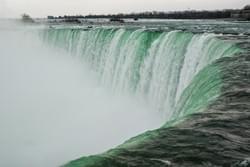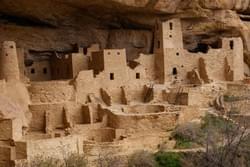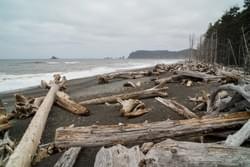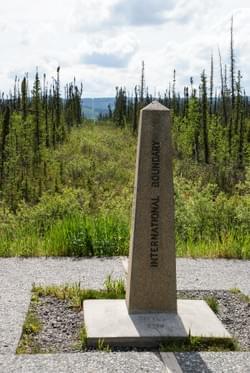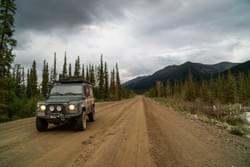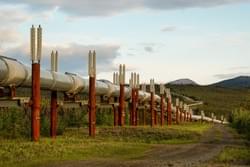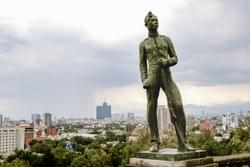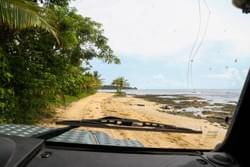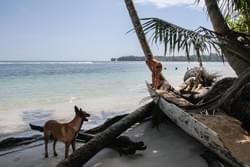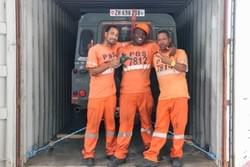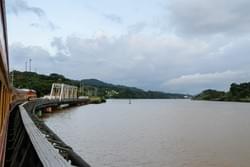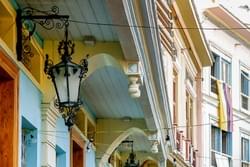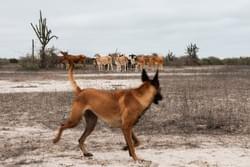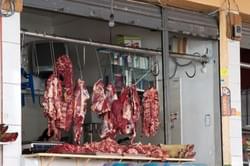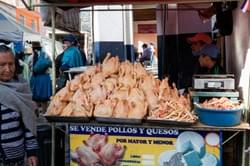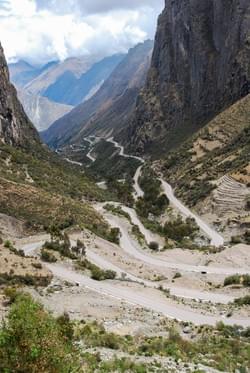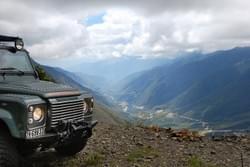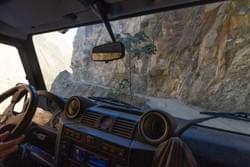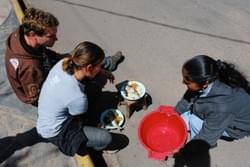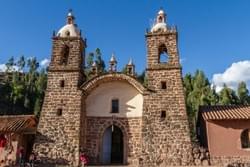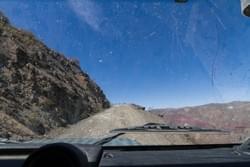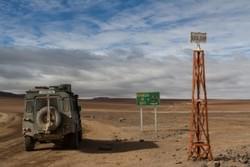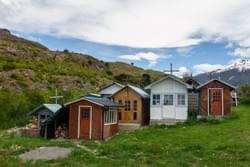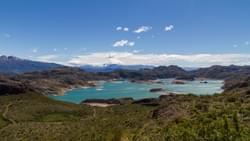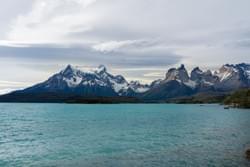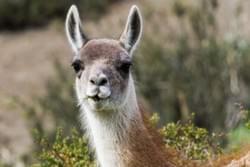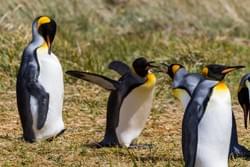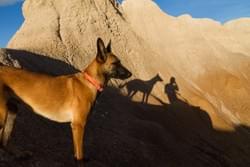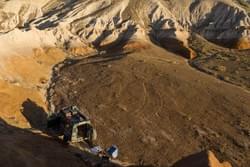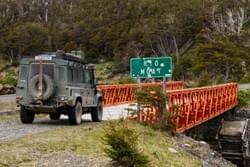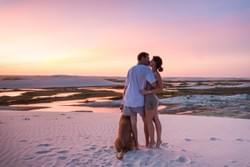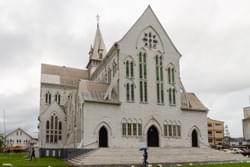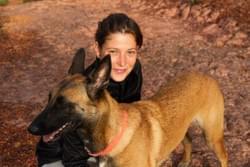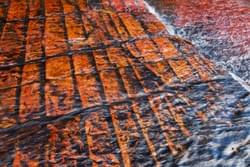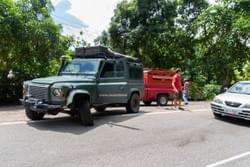



3 years, 130’000 km, 2 continents
We gathered our first Overlanding experience in a Land Rover Defender before we even knew "Overlanding" was an actual term.
In short, we shipped our small green vehicle from Europe to Boston, drove across the states, then north to Prudhoe Bay, Alaska. From there we headed all the way south to Tierra del Fuego, Argentina and back up north more or less along the Atlantic coast to reach Venezuela. We learned a lot in those three years and also made some life-changing decisions which were the baseline for how we are living our lives now.We had shipped our Defender from Switzerland to Boston and started our route towards the Niagara Falls, Badlands NP, Mt Rushmore, Devils Tower to the Great Sand Dunes NP, Mesa Verde NP, making a loop to Utah to play around in and around the Arches NP (Wall Arch was still there). In between, there was a lot of driving on the straightest roads we had ever seen, day after day towards the west.
We also got our fair share of getting bogged, back then we did have a winch luckily. We also got to shoot a gun and drive Skidoos through the forest with some nice Wyoming residents. They also showed us around the coal mine where they work, maybe that’s where Mike started thinking of bigger trucks. Then we got covered with snow overnight in the Great Sand Dunes NP, which wasn’t very pleasant when sleeping in a rooftop tent.
Finally, we ended up on the West Coast, visited La Push (there weren’t any Vampires there back then), and stayed with a good friend in Seattle. She showed us around, I, Andrea, turned blond (because why the heck not!?), and we sold our rooftop tent.From Oregon, we continued to Canada, took the ferry to Vancouver Island where we encountered several bears, and tried to catch wild geese for dinner with a loaf of fresh-baked bread. Of course, we ended up with neither of them, but the geese had their bellies full of bread.
Continuing north through BC and Yukon to reach AK. We got stuck in a riverbed, trying to get closer to the „Into the Wild“Bus, eventually, we ended up having a beautiful camp in the forest(and surviving!). The Dalton Hwy from Anchorage to Prudhoe Bay offers beautiful sceneries and plenty of mud. This was the first stretch where we had to calculate our Diesel capacities. Luckily we were able to fill our tanks in Prudhoe Bay (yes, it was very windy). The really cool part of driving the Dalton Hwy was that the days were crazy long! I remember switching to drive, keeping going for hours and hours until we realized it was almost midnight but the sun was still up.
Driving back through Canada, we did visit Dawson City, Jasper NP, and Banff NP but were kind of in a hurry because some friends were waiting to meet up. We will have to spend more time in Alberta next time.
Montana offered total freedom. We camped in the woods, made big bonfires, eat the biggest steaks we had ever seen, swam in huge lakes.
Continuing sth to YellowstoneNP (which was totally crazy because of the wildlife and nature but also the number of tourists), Grand Teton NP, eventually to Salt Lake City and the Bonneville Salt Flats. Didn’t do any racing or speed records but-almost-got stuck again. Yosemite was nice, but also really crowded. We stopped at Mono Lake to see the Tufa formations, didn’t do any handstands in the water but we did wish you were here;) We looped across to San Francisco to then drive to Death Valley where we pushed some rocks around. Grand Canyon was fun until Mike chopped his knee with an ax which led to a reroute to the nearest hospital, driving like a f-ing lunatic. So we obviously didn’t go hiking much in the next few weeks, we’ll have to go back to that part of the States too. We limped around Vegas and had an IHOP pancake tower for breakfast.
The west coast was really pretty to drive, we took loads of photos.
Next, we wanted to continue south, towards Mexico and Central America.We crossed the immense border from San Diego to Tijuana to head down Baja California. We crisscrossed from the eastern to the western coast, with rough seas and strong winds on the Pacific side and very hot (up to 50C/122F) and zero wind in the Gulf of California. We even spent an afternoon laying under the Landy because it was the only shade during noon. …leaning again a cactus wasn’t really an option.
Mike got swept into the ocean by a huge wave while trying to catch some fish. I almost thought I’d never see him again.
From La Paz we took a ferry to Mazatlán, where most roads were blocked due to heavy rains. So we quickly made our way to Mexico City, where my sister lives. It was nice having a place to dry everything after the continuous rain and dampness. We spent a few weeks in the 21million capital, FYI it takes several hours to drive across this city in normal traffic! We ate some grasshoppers, visited Teotihuacán (largest pre-Columbian city in Mexico), the Castillo de Chapultepec, and many cool insider places that blew our minds.
After a few weeks, we continued to the Caribbean, visited some more ruins and Agua Azul, spent a week in a lovely small beach house of a stranger, and then crossed over to Cozumel. We intended to drive all the way to the most northern point of the little island. The road was pretty shabby but fun and boy was it worth the drive! We spend the next few days camping near the lighthouse, swimming in shallow crystal clear water, enjoying life.
Our three-month Mexican visa ran out, so we drove on to Belize. A funny little country that doesn’t seem to fit in in Central America. It’s own culture, language, full of contrasts, very non-latino, and very interesting. From Rastafaris to Quakers, all living in this tiny country (it’s even smaller than CH!). Roads connected with hand-operated ferries. Mayan ruins in the jungle. LOTS of mosquitoes on the coast and untouched forests.
Guatemala offered lots to see, more Mayan ruins, beautiful old Antigua Guatemala, Lago Atitlán, riverbeds to get bogged in, good times.
We then quickly made our way through El Salvador, Honduras, and Nicaragua to Costa Rica. The „end“ of the first year on the road.After spending some months in Costa Rica, we continued south to Panama. My brother Robin came along for some part of the stretch. We took the ferry across to Bocas del Toro, spent some days hanging at the beach, SUPing, even Aimée got on the board. We enjoyed the days in this Caribbean paradise, knowing a lot of paperwork and customs lay ahead of us, so we could continue to South America.
In Panama City, we said goodbye to Robin and got the export paperwork done for the Defender, to then drive to Colon to get our car into a container. That worked really well, pretty hassle-free. Colón is on the Caribbean side of Panama and we had to get to Panama City, which is on the Pacific side. To get across we took the Panama Canal Railway. Because there are no dogs allowed in the train compartment, we had to ride along in between the wagons, pretty windy, but the views were nice.
We had a few more days in Panama City before we would fly to Ecuador. Just a day before our flight, we found out that we would need a special permit to exit the country with Aimée. Panamanian customs are quite … work-shy … and we had to do a lot of convincing and sweet-talking to get our papers done in that one day. Anyway, it all worked out, we got the flight after arguing with an airport official who was afraid that Aimée would escape her kennel and bite him, and he didn’t want to take her on board because of that.
Finally, the airplane took off with all three of us on board and we were looking forward to exploring South America. Next stop Guayaquil, Ecuador.After a few days in Guayaquil, we got the Defender out of the port and were ready to hit the road again.
We followed the Ruta del Sol all the way to the north, enjoyed the fresh seafood (best Arroz con Camarones EVER!) that is available on every corner, the empty beaches, and visits from turtles. Heading inland was a complete change of scenery. From an arid, hot coast, to lush tropical hills and later cold, thin-aired Andes.
Of course, we had to visit the famous market in Otavalo. We don’t know how touristy it is now (we were there 9 years ago) but it’s totally worth a visit, don’t forget your camera.
Then we had the brilliant idea to drive to the Laguna de Mojanda, where our shovel and max trax got some action. …slide to photo Nr. 7… after several hours of shoveling, we got to practice a deadman anchor. Good times. The Laguna de Mojanda is at 4263m asl (13986ft) so shoveling is a lot more exhausting. Anyway, we made it out and had a lovely camp above the Laguna.
The name „Ecuador“ says it all, of course, we visited the monument marking Latitud 00°00’00” and took that mandatory photoWe spent two full months in Peru.
Driving south along the arid coast to Lima and then east. We visited the must-sees like Ica and Nazca. Took some time to reach Cusco, because there are so many nice spots on the way. In Peru the liberty of just camping anywhere is beautiful. People are friendly and the landscape is breathtaking. Before reaching Cusco the first high mountain passes start, helping to get acclimatized to the thin air.
Just before Cusco, the EGR valve failed which resulted in a complete loss of power of the engine of the Defender. We were still able to drive but only in the low gears so the rest of the mountain passes (over 3000m asl high) were a b****. We finally got to Cusco and found a mechanic who normally works on rally cars and allowed us to sleep in the car in this garage. Three weeks went by until the spare part arrived (it took two days to arrive in Lima and the rest of the time was consumed by the Peruvian customs). By the time it arrived, we had acclimatized really well to the 3400m asl (11150ft) which was great considering the next stage we had in front of us.
We also used the time to hike Machu Picchu and of course explore Cusco well behind the tourist center.
Once the Defender was back up and running, drive across the Altiplano to reach Lake Titicaca. We did the normal touristy visit to the floating islands and spent the last night in Peru at the shore of Lake Titicaca.
It’s really hard to sum up two months packed with rich culture, unique landscapes, visits to archeological sites, meeting locals, and eating street food, so the pictures will tell the rest.Bolivia. The land of contrasts.
It has the world's highest capital city (3600m asl / 11811.02ft), towering peaks around the famous altiplano which stretches into the driest desert of the world, while the east of the country is part of the Amazon region, humid and densely-forested.
The first challenge we encountered in Bolivia was finding not insanely over-expensive Diesel. A few months earlier the law had changed so that tourists had to pay horrendously high fuel prices. Apart from that, there was no Diesel. We drove across la Paz and only on the other side, the last gas station had some left.
Long story short, we drove some backroads to Sucre, which was interesting because back then we navigated with maps (with rather small scales) and we reached our limits of communication when in the remote towns no one spoke Spanish anymore, but Quechua. Never the less, we found Sucre, spent some nights in the colonial-style city, and then headed on to Potosi where we got caught up in a street riot. We backed up just in time and took a dodgy road around the shutdown area.
In Uyuni, we filled our tanks to the absolute max to be sure that we could reach the first town in Chile. The next stage involved crossing the famous Salar de Uyuni. The sunset on the salt flat was extraordinary. You could lay on the ground and see the sun just above the horizon on one side whilst on the other side, the sky was already dark and the first stars were showing.
Driving to the Laguna Colorada we reached 5300m asl (17388.45ft), the highest we have ever been but we felt good, even Aimée tried to hunt some Vincuñas.
The border post to Chile was surreal as the country itself. A tiny hut with one official who takes down your information into a huge book, a big loud stamp in the passport, and you’re good to go.Chile bears many beautiful places along its 4275 kilometers from North to South.
We missed out on the Atacama desert because our double prop shaft was broken, so we decided to not drive into the sand with only front-wheel drive… We ordered the part ahead to the next Land Rover dealer in Argentina.
Driving south to Ushuaia, we zig-zagged across the Chilean/Argentinian border several times. Picked up the part and kept driving south.
We were (still are) totally fascinated by the Carretera Austral of Chile. It rained a lot when we were there which gave the landscape a very mystic touch. We hiked up to the Ventisquero Colgante, an impressive glacier calving over the edge of a huge cliff. Found some mural paintings. In the Torres del Paine National Park we found this amazing spot to camp where we had a full view of the majestic mountains and we saw the first icebergs in our lives.
From a fellow traveler, we had heard about a King Penguin colony on Tierra del Fuego. Back then it was only open for researchers, now it’s a National Park, but we sweet-talked our way into it and spent the whole afternoon observing the penguins, just by ourselves.Heading south zig-zagging through Chile and Argentina we had driven some part of the seemingly endless Ruta 40.
In Bariloche, we ate the best empanadas EVER. Camped by beautiful lakes with the surroundings covered in volcano ashes, of course, the car was then full of that too. We wouldn’t have needed any dog food with all those huge bones Aimée found.
We spent a night in the Perito Moreno Ntl Park to see the sunrise over the glacier.
Finally, we reached the "End of the World“, Ushuaia, where we spent some days exploring the most southern coast of the continent.
The Atlantic coast is rather dry and windy but we had (really) close encounters with Magellanic Penguins (love those little fellas) and Sea Lions. We even camped on a beach only a few meters from a Sea Lion colony.
Near Mar del Plata we saw the start of the Dakar Rallye. I think that’s where the idea of a bigger truck was planted in Mike’s mind. The Start of the Rallye was on the 1st of January, so we spent New Year's Eve on the beach with all the local Dakar Fans, making bonfires and the famous Argentinian BBQs. After the Rallye we stayed on the beach some more, made more parrilladas and we got to ride the ATVs on the dunes of the beach.
Argentina is not an easy country to plan your trip to, because there is so much to see and the country is so big. So we spent a few more days on the coast, planning our next steps to see the north of Argentina, Paraguay, Uruguay, and Brazil.We got up early to stroll through the empty streets of Buenos Aires and headed off towards the northwest of the country, to drive the rest of the Ruta 40.
It rained a lot in the following weeks, the roads were muddy and slippery, the best spots we found to camp was often a truck stop. On one road the red mud was so slippery that we slid off it in a turn. We had no chance to get back in it other than sing our winch.
Other than that the landscape reminded us of Utah, we camped in dry canyons and riverbeds, even the architecture changed, the north of Argentina looks like a completely different country.
From Salta we drove to Asuncion, Paraguay to meet up with an old friend. Spent a few days seeing the city from a locals point of view. Itaipu Dam was the next poi coming up. We even visited the night tour where the whole dam is light up in different colors, pretty impressive.
Iguazu was one of the biggest highlights on this stage. We had to visit both sides (Paraguayan and Brazilian ) of the Waterfalls to get an idea of the actual size but we still didn’t get to hike all the paths.
In Paraguay, we spent some days at the coast, with a view of the skyline of Punta del Este. A few days later we would cross the border to Brazil, practicing some Portuguese to hopefully be able to communicate somehow.Brazil was not the easiest country to overland for us. We could handle getting through with Portuguese but it was REALLY hard to find nice spots to camp. Mostly in the south though, the further north we drove the better/easier it got.
Many of the famous beaches in southern Brazil are fenced off because there’s a resort, a condo or it’s just private. So you can’t even access it. Most of the time we slept at truck stops. That was not too bad, we felt safe, most of them had nice showers and water to refill our tanks. But it wasn't very…picturesque. Still, we enjoyed exploring the must-see towns or sightseeing spots but were happy when it got less crowded further north.
I don’t recall from where but at some point we just camped beaches where the next one was more beautiful than the last. We drank coconut water fresh from the palm trees, on one beach fish got thrown on the beach by the waves so we didn’t even have to fish, we could just pick them off the sand. Life was good.
In Sao Luis, we got invited by a local family to spend the weekend with them, as the Bumba meu Boi celebration was taking place. And man was it worth it! We are so grateful to have met this lovely family who took us in and showed us their city, cooked traditional food, and shared a tiny part of their life with us.
Our plan was to head to the Guyanas, so somehow we would have to cross the Amazon River. We decided to take a „ferry“ across the Amazon Delta from Belém to Macapá. In Macapá, we crossed the Equator once again (we had crossed it in Ecuador over a year ago) and headed on to our next destinations, the Guyanas and Venezuela.At the border of French Guyana, the officials welcomed us „home“. French Guyana is part of France, so it’s also part of the EU, we could technically have stayed for as long as we wanted.
We REALLY enjoyed the french food. We got all the yummy french cheese and fresh baguettes. In Kourou, we visited „Europes Gateway to Space“, an ESA spaceport! AND, a week later a rocket would be launched into space. We couldn’t miss that! So we lounged around Kourou for a week, enjoying the food and the beach (could be worse!) and kind of fell in love with the little town.
The rocket launch was exhilarating! We could see it flying all the way to space until it was too small to identify in the blue sky. We'll share more photos in the stories.
Suriname, is a weird little country, no offense. Over a 1/3 of the population is Hindustani, which is reflected in the architecture and the official language is Dutch, two things you wouldn't expect in Sth America!
From Guyana (an ex-British colony, so a left-hand drive country) we drove a muddy track to the border with Brazil and from there, north to Venezuela.
We were hoping to see the Tepuis, but due to bad weather, we only saw them covered in clouds.
A few days later we had one of the worst days in our lives. A lady smashed into us with her car, our Defender was totaled, the trip was over, time to go home. This happened very far in the south of the country, where it was hard to get in touch with anyone or even to organize a tow truck. Luckily a very sweet family invited us into their home, Defender parked up front, and we could make daily trips with the local taxies into town to have internet access and phones.
A tow truck then took us to Caracas. 3 days drive. We even slept in the Defender on the tow truck.
Long story short, a day before our 3month visa expired we were finally able to leave the country, having put the Defender in a container, made daily dreadfully long trips to the port or banks or offices or swiss embassy. Our feelings were in turmoil, we had to get through this super complicated export process before we could even start to process our feelings about the crash. But we met some very sweet people and the whole situation would have been so much worse without their help.
Copyright © 2017 - 2024
4-xtremes. All rights reserved
info(at)4-xtremes(dot)ch







